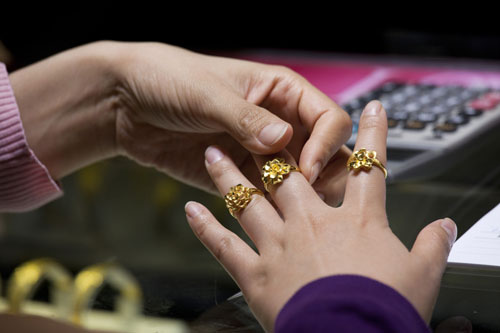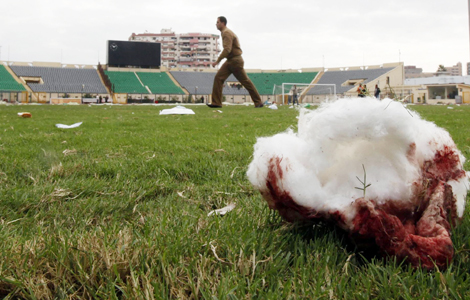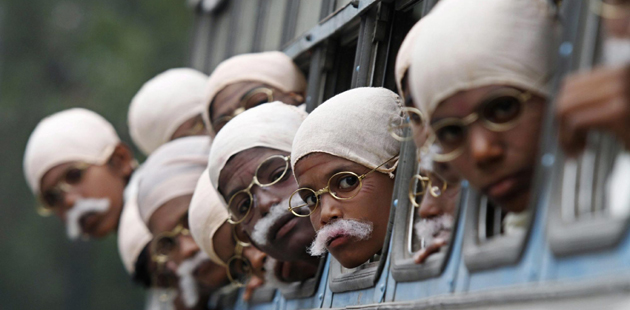Chinese snap up luxury products
Updated: 2012-02-07 09:34
By Wang Zhuoqiong (China Daily)
|
|||||||||
Observers predict nation will soon be biggest in the world for high-end designer consumer goods
BEIJING - Chinese people will buy more than half their acquisition of luxury goods on the mainland in 2014 rather than overseas, as is the case now, business research and consulting firm Frost & Sullivan said in its latest survey.
|
 |
|
A woman trying on gold rings in a Chow Tai Fook Jewellery Group store in Hong Kong. Chinese people spent $7.2 billion overseas on luxuries during the Spring Festival holiday last month, according to the World Luxury Association.[Photo/China Daily] |
The United States-based company said 53 percent of high-end brands purchased by the Chinese will be from the mainland in 2014, rising to 55 percent in 2015. In 2011, 52 percent of luxury goods bought by the Chinese were from abroad, the survey said.
Zhu Yue, a consulting director with Frost & Sullivan, said the tax on designer goods is expected to be lowered in 2012, which would attract more customers.
"The retail price of luxury goods keeps rising in overseas markets, even faster than in the domestic market," Zhu said, adding that buyers would begin to notice the price gap narrowing.
Wealthy Chinese bought more than 100 billion yuan ($16 billion) of luxuries in the mainland market last year, with a year-on-year increase of at least 25 percent, management consultants Bain & Co said in its latest report on the 2011 Chinese high-end market.
China is expected to surpass Japan as the world's largest luxury market this year, according to the consultants.
Chinese shoppers are in the limelight in the global market. Every single coin they spend on high-end brands attracts the attention of global market researchers, including the World Luxury Association, Frost & Sullivan, Bain & Co, Price Waterhouse Coopers and iResearch Consulting Group.
Just three days after the Spring Festival holiday, the World Luxury Association announced in a report that Chinese travelers spent $7.2 billion abroad on luxury goods during the week-long holiday, up nearly 29 percent from the $5.6 billion during the 2011 Spring Festival holiday, making the Chinese the most powerful purchasing group.
About 72 percent of Chinese people interviewed believed that luxury goods overseas are cheaper than at home. A total of 69 percent travel because of the wider choice available and 45 percent enjoy the products' authenticity and the service at overseas outlets.
The report also said most money was spent on luxury watches, leather bags, designer clothes, perfumes and cosmetics.
Over the past few years, demand for finer products has maintained a strong growth momentum in China despite a plunging luxury market in many developed nations as a result of the effects of the global financial crisis.
According to the 2012 Outlook for the Retail and Consumer Products Sector in Asia released by Price Waterhouse Coopers, China will be the top contributor to global growth in luxury sales and Chinese tourists are fueling demand in key global cities, accounting for 56 percent of China's spending on high-end brands.
Chinese customers are expected to buy a total of 570 billion yuan of high-end products in domestic and overseas markets by 2015, according to another report released in December by Frost & Sullivan.
The researcher recorded a growing demand by Chinese consumers for luxury goods.
Among the most desired items are handbags and leather accessories, which have experienced a particularly high level of growth in sales, the report said.
Chinese people spent about 14 billion yuan on designer handbags in 2010, compared with about 12 billion yuan for leather accessories, in the domestic market, with compound annual growth rates of 30 percent and 37 percent respectively over the 2006 level, according to the report.
Zhu of Frost & Sullivan linked the surging demand for quality branded handbags and small leather goods with the fledgling luxury market on the Chinese mainland and "immature" domestic consumers.
"The prices of these durable items are acceptable," Zhu said, adding that many Chinese buyers sport high-end products in order to show off their status and identity and to be noticed.
The Chinese spent 16.9 billion yuan on cosmetics, perfume and healthcare products, followed by 15.5 billion yuan on watches, the report by Bain & Co showed. The report also said that suppliers of high-end products earned 68.4 billion yuan from wealthy Chinese in 2010.
The Frost & Sullivan report attributed the growing demand for branded quality to the "increasing number of wealthy individuals" in China.
In China, the number of wealthy individuals with a disposable income of more than 100,000 yuan, increased to 21.7 million in 2010 from 8.7 million in 2006, according to the report. It forecast the number would hit 54 million by 2015. "The group is a potential for future growth in demand for luxury goods," the report added.
Government policies to spur domestic consumption are another factor contributing to the growing luxury retail market, the report said.
During the financial crisis in 2009, the Chinese government unveiled a 4 trillion yuan investment package to reduce its over-reliance on exports and stimulate domestic demand.
"Increasing living standards, a growing urban population and anti-piracy laws and regulations" also contributed to the increasing demand for luxuries, the report said, predicting second- and third-tier cities will become markets for the expansion of top brands.
Zhu said that although the growth of the high-end market in lower-tier cities outpaced that in first-tier cities, markets in Beijing and Shanghai could still maintain double-digit growth.
Another report released by the Research Center for Luxury Goods and Services at the University of International Business and Economics (UIBE) in Beijing also saw potential growth for markets in lower-tier cities.
Cities such as Hangzhou, Shenyang, Chengdu and Qingdao would become the main markets for competition in the luxury brand sector, said the UIBE report, predicting sales in Hangzhou will reach 8 percent of the domestic sales volume, followed by 6 percent in Shenyang, 5 percent in Chengdu and 3 percent in Qingdao.
"Markets in first-tier cities such as Beijing and Shanghai are highly mature," said the UIBE report, adding that in lower-tier cities, the limited marketing and promotional activities and sales channels would challenge the expansion of designer brands.
"But e-commerce services for the brands would make up the gap," it added.
On the Chinese mainland, the online transaction volume of luxury goods was 6.36 billion yuan in 2010, said a report published by iResearch Consulting Group. It expected it to reach 10.73 billion yuan in 2011 and 21.32 billion yuan by 2013.
Because of limited sales channels, limited brands and choices available, Chinese people prefer purchasing luxury goods in overseas markets, causing a huge imbalance in buying volumes between domestic and overseas markets, said the Frost & Sullivan report.
It said wealthy Chinese bought 123 billion yuan of luxury goods in overseas markets in 2010 compared with 95 billion yuan in the domestic market.
However, it expects the purchasing of luxury goods on the Chinese mainland - 46 percent of global consumption last year - to surpass that in overseas markets by 2014.
According to industry insiders, the imbalance is mainly driven by the huge price gap of luxury items between domestic and overseas markets, with much higher taxes imposed on high-end goods creating higher prices on the Chinese mainland.
According to Ouyang Kun, chief of the World Luxury Association's China office, many other countries do not impose tax on luxury goods, so the prices were lower there.
Chen Keyu contributed to this story.








